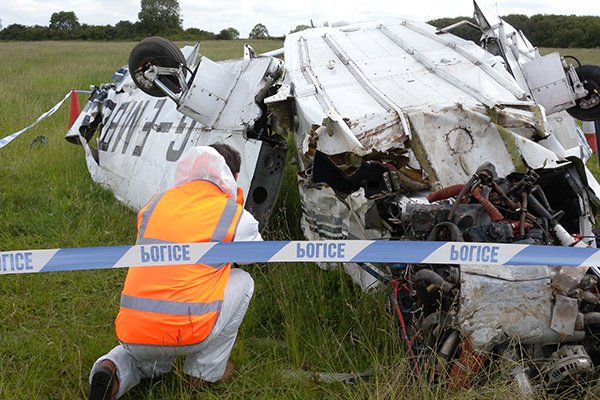
Effective management of an aircraft accident site is fundamental to a successful safety investigation and a well-managed accident site will maximise the quantity and quality of critical evidence harvested. Get it wrong, however, and the potential for fatally compromising your safety investigation and physically or mentally harming people is all too real.
Ever heard of Practical Leadership Tasks (PLTs)? For example: "With your team you are to cross this crocodile-filled ditch using only two toothpicks and some sticky-back plastic." In essence, an aircraft accident site is potentially the "mother" of all PLTs. The good news is that the same management ground rules pretty much apply to all accident sites; it is just the scale and magnitude of the challenge that changes - i.e. a small microlight in a farmer’s field to the ultimate Pan Am Flight 103 "test" (although granted Pan Am Flight 103 wasn’t technically an accident).
Managing aircraft accident sites 101
In very basic terms, to protect your evidence and safely maximise the collection of potentially critical evidence you must establish effective Command and Control (C2) of the accident site. Like most military and ex-military people, I love acronyms and mnemonics. Three Letter Abbreviations (TLAs) and Four Letter Abbreviations (FLAs) are the lifeblood of military speak and serve an important purpose when working as a team to solve a complex and dynamic challenge. They can give structure and a mutual understanding of command’s intent, or, in this case, the Investigator In Charge’s (IIC – boom, another TLA right there) cunning plan.
Accident investigators are not first responders and are generally most likely to arrive after first response organisations have completed the rescue and life-saving phase. The accident investigator will hopefully have a rough mental model of the accident they are deploying to, gleaned from information supplied during the accident notification process. The investigator will have formed a generic evidence "wish list" and a Generic Risk Assessment (GRA) based on this initial information. However, experience tells the investigator that initial information can be of varying quality and quantity so they will be seeking to update the plan with the realities of what they find at the accident site.
Accident sites by their nature have multiple agencies working side by side, each of which has a specific role and responsibility. The investigator must engage and work with all these agencies to ensure that potential evidence is protected at the accident site while other agencies complete their activities.
At the Cranfield Safety and Accident Investigation Centre (CSAIC), we principally work with accident investigators from air, marine and rail transport modes and have developed a framework to help us teach the basics of cat herding and fog knitting based on an expanded C2 concept. We take C2 and expand it into the 4Cs:
- Communication
- Caution
- Confirm
- Control
So how does this work in practice, I hear you ask? As we know, accidents can occur over land or water, in urban or remote locations, desert or mountains, the arctic or jungle. In this blog, I am going to generically talk around the most common type of aircraft accident in the United Kingdom - i.e. Civil General Aviation (GA), over land, non-remote, temperate - aka "plane in a farmer’s field". The general principles can still be applied to other accident sites and other transport mode accident sites but I’ve got to start somewhere, so here we go!

1. Communication (talking to the cats?)
In the example above, there will invariably be a designated on-scene incident commander from one of the first response organisations. The investigator will arrive at the accident site and seek out the on-scene commander to commence the communication process; in other words, "have a chat". Diplomacy is key and the investigator will seek to download the incident commander of their knowledge and understanding of the accident site. Part of this conversation can include what the first responders have discovered, what they have done, what they haven’t done, the location of any fatalities or casualties and what they have disturbed or not disturbed (e.g. batteries disconnected) during any rescue activities.
Hopefully, the incident commanders will have carried out their own Risk Assessment (RA) of the accident site and the investigator will be keen to uplift this RA into their own RA process (more of this later). The communication flow should also include baseline discussions to agree who has primacy and who has overall responsibility for site safety. Following this initial unidirectional communication, the investigator will naturally engage in multidirectional communication. What I mean by this is that they are going to have conversations with the other investigators in their team, other agencies working on the site and their own senior management back at base. This multidirectional communication must, must, must be positively maintained while on-site activities are ongoing, to ensure the safe and efficient conduct of the safety investigation.
That’s enough on Communication – now, what about that Caution stuff?
2. Caution (fog and big cats and big cats in fog can be dangerous)
Accident sites by their nature can be hazardous places to work for the untrained or unwary, as normal health and safety, safe systems of operation and safety systems et al have most likely either been defeated or compromised. In order to identify, record and harvest the evidence at an accident site, the investigator needs to identify the hazards present, calculate the risk they pose and implement effective risk management strategies to reduce the risks to as low as reasonably practicable. Investigators need to be hazard-intelligent and risk-pragmatic, hence the investigator’s download of the incident commander’s RA to gain an improved understanding of the hazards and risks that may be present.
Having gained this information, the investigator can now update their pre-prepared GRA to an initial Dynamic Risk Assessment (DRA). The key word here is "dynamic". The DRA is a living and breathing RA that is a constant cyclical process of checking, confirming, modifying and updating to manage hazard and risk. The DRA process is based on identifying hazards from five key groups:
- Environmental
- Physical
- Material
- Biological
- Psychological
The investigator then determines the likelihood and severity of the risk that the hazards pose, in order to determine what risk management strategies they will need to employ. At complex accident sites the investigator may need to engage with Subject Matter Experts (SMEs) to identify and manage challenging and complex hazards. The GRA/DRA process can be formal or informal but many organisations are moving to a formal recording of their GRA/DRA process as part of their Safety Management System (SMS). The most efficient way to inform this DRA process is, whenever possible, for the investigator to physically walk the accident site and get "eyes-on" the problem to check, confirm, modify and update the DRA.
This moves us very neatly on to Confirm.
3. Confirm (how many cats and of what type?)
The military have a fantastic maxim: "Time spent in reconnaissance is never wasted." This is so true and the confirm phase is essentially that "eyes-on" walkthrough of the accident site. The walkthrough is a mixture of critical confirmatory and informing tasks.
Firstly, to check and test that their first pass DRA is valid and, if necessary, to check and adjust as required. Secondly, to confirm that all the parts of the aircraft have arrived at the accident site and if not, where are they? Thirdly, to identify critical and/or perishable evidence present and to start planning the order of priority for evidence collection and finally, to confirm the size, extent and probable outer perimeter of the accident site or sites.
There are a number of ways to achieve this goal. You can start at what you assess as the outer edge of your accident site and spiral in or start at the main wreckage and spiral out. You can start at the main wreckage and walk back along the wreckage trail to find the first impact mark or you can do the reverse and find the first impact point and walk to the main wreckage. The dynamics of the accident or the terrain in which the accident has occurred may well dictate the best method to use but it doesn’t really matter how you do it, just that you do it methodically and comprehensively. Applying this in a different scenario; if your aircraft accident site is on the seabed then your "eyes" may well be the helmet camera of a commercial diver or the on-board camera of a Remotely Operated Vehicle (ROV).
Having completed the walk-around and now armed with a reasonably accurate understanding of the unique challenges of the accident site, the investigator can now start to formulate an action plan and take effective C2 of the accident site.
So, moving on to Control…
4. Control (herding the cats and knitting the fog, aka cat whispering)
Simplistically, control of the accident site means controlling access to the evidence. The more populous the area in which the accident occurs then the harder it will probably be to control - e.g. it’s dead easy if it’s in the middle of a desert! By controlling access to the evidence the investigator can best protect the evidence until they can get to it. Easily said, but in some situations it can be quite challenging to actually achieve. Effective control of the accident site will also ensure only competent, authorised and suitably trained (hazard and evidence aware) personnel are allowed access. This allows the investigator to effectively manage site safety by ensuring individuals entering the cordon have been appropriately briefed on the hazards present and risk management protocols in place and are correctly wearing appropriate Personal Protective Clothing (PPC), Personal Protective Equipment (PPE) and Respiratory Protective Equipment (RPE), should it be required.
Physical control of the perimeter of the accident is in practice established by the use of "barriers". These can be as simple as "do not cross" barrier tape cordons but can include natural barriers such as hedge lines, ditches, watercourses and existing fence lines. Being in the middle of a desert or jungle is also a rather effective "barrier".
And relax… Well that’s enough of me spouting on. Hopefully the above has been useful and given a little structure to what can be a complex but vital phase of the accident investigation process. In short, talk to the right people all of the time, keep you and everyone else safe, make sure you understand the dynamics of the accident site you are dealing with and then manage it to the best of your ability.
The great thing about the accident investigation community is that everyone has differing ideas, opinions and experiences. Some out there may mildly or strongly disagree with the thought process and methodology of the 4Cs and that is absolutely fine. The one thing I am constantly reminded of is that every accident, by its very nature, is unique and there is no "one" way to success. There are rarely easy "black and white" decisions of the "when faced with this, then do this" type of problem-solving, but rather "grey" problems where you have to make either an individual or collaborative decision based on knowledge, training and experience. The key take-away is to have a structured process that at least gives the investigator a framework on which to hang a cunning plan and then dynamically amend the cunning plan as they go.
Interested in learning more? Then here at the Cranfield Safety and Accident Investigation Centre (CSAIC) we offer a number of accident investigation-focused CPD courses, from a two-day Hazard and Evidence Awareness for Air Accident Responders course; our world renowned three-week Fundamentals of Accident Investigation (multi-modal) course and three-week Applied Aircraft, Marine or Rail Accident Investigation courses; through to our three-year part time MSc programme in Safety and Accident Investigation (Air, Marine or Rail Transport).
Footnote: No cats were harmed during the writing of this blog.
